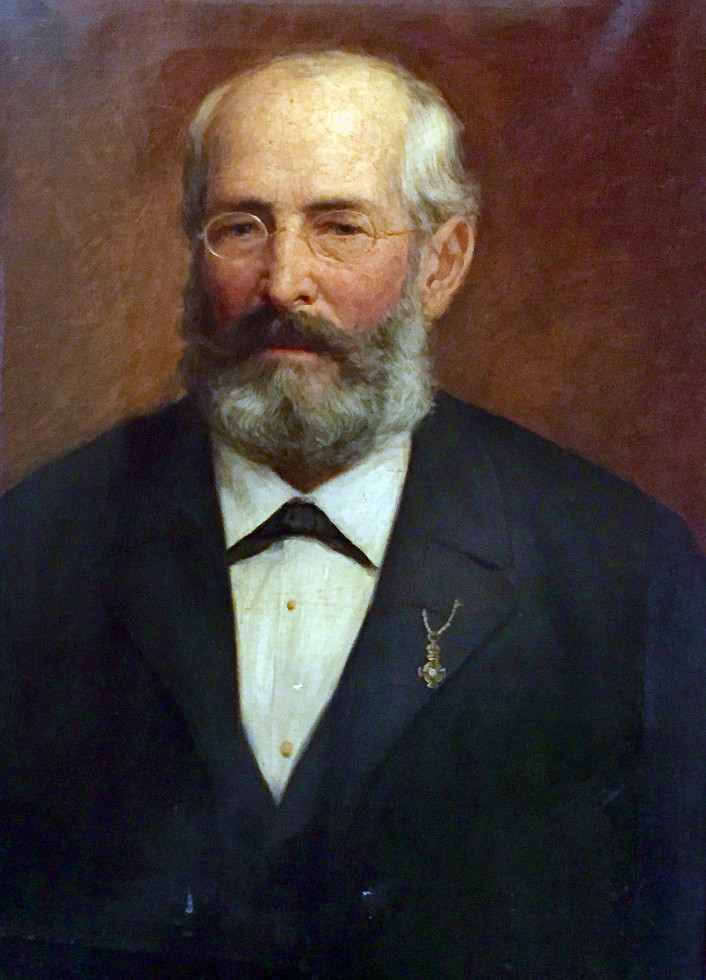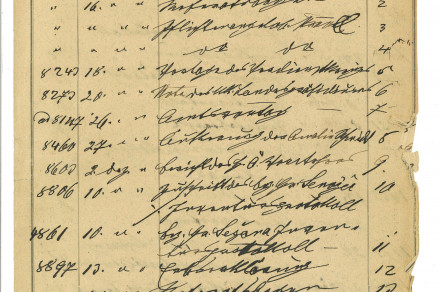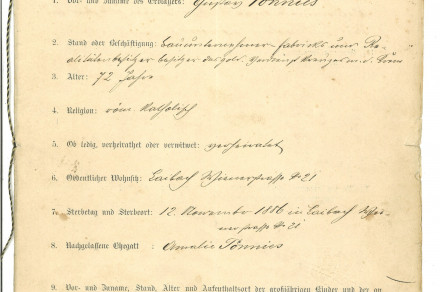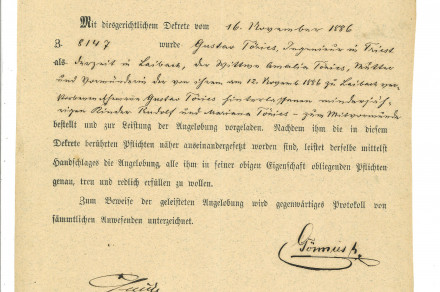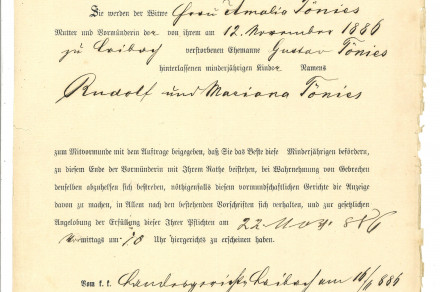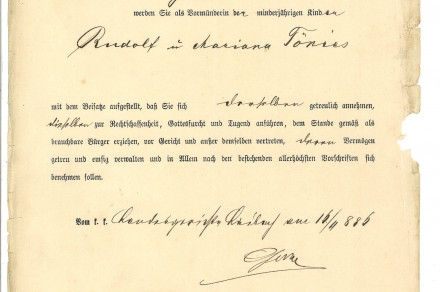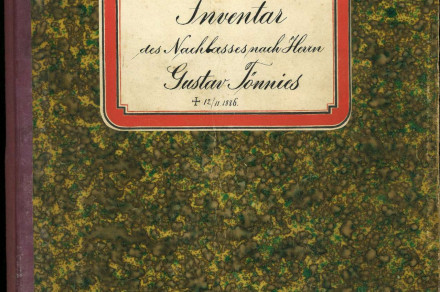Gustav Tönnies (1814–1886) and His Legacy
Probate recordsof of Gustav Tönnies
Preserved among the archival holdings of the Archives of the Republic of Slovenia are also probate records of Gustav Tönnies, founder of one of the most enterprising and successful families in the territory of the 19th century Slovenia. Born in the Swedish town of Stralsund in 1814, Gustav Johan Ludvik Tönnies studied and acquired practical work experience throughout most of Europe, residing in places from France to Russia, which is evident from his master certificates that are currently kept by his descendants. In 1845, upon the invitation of Mayor Hradetzky, he came to Ljubljana from Graz to build the roofing of the Coliseum/Kolizej building. Another purpose for his coming to Ljubljana, however, were numerous business opportunities offered by the construction of Vienna-Trieste railway. In Ljubljana he founded a carpentry company and expanded his business into areas such as construction, building material production, foundry and mechanical engineering. He married Amalija Malovrh (1829-1906), whose father Marko Malovrh owned several inns in Ljubljana, among them also Zum Deutschen Ritter inn, known today as Pri Mraku inn on Rimska Street. Gustav and Amalija went on to have nine children (five sons and four daughters). His sons were after their respective studies actively involved in the family companies, retaining the continuity of the family business up until the end of WW2.
Gustav Tönnies worked in the construction of train stations along the railway line Ljubljana-Trieste, Ljubljana-Tarvisio. In Trieste he built harbour warehouses and the railway station. In the second half of the 19th century and the first half of the 20th century, his construction company built a number of well-known public buildings in Ljubljana, such as the Opera House, the Courthouse, the Mladika complex, the Bank of Slovenia building, the Ljubljana Palace/Ljubljanski dvor, the Ljubljana Post central building, as well as many industrial complexes, such as Kozel Brewery, the Tobacco Factory, the Sugar Refinery/Cukrarna and many other prominent residential facilities in Ljubljana. His company also built the Koseze Brickworks in Ljubljana and the “Machine Factory and Foundry in Ljubljana” (1871), which became the foundation for Litostroj Company after the war. In 1858, he set up the first steam saw in Ljubljana and owned a joiner’s and parquet workshop. From 1845 to 1884, his company was operating also in Graz, Trieste and Tarvisio. He purchased quarries in Aurisina, Momjan and Monrupino, which were after his death up until 1918 managed by his son Emil. His industrial construction company was the largest of its kind in Carniola up until the foundation of the Carniolan Construction Company in 1873. After the 1895 Ljubljana earthquake, Tönnies’ company was one of the largest building companies in the area and so played a major role in the rebuilding of Ljubljana. This was a time when most of the new public buildings in Ljubljana were built. When commemorating the 600th anniversary of Carniola’s annexation to the Habsburg Monarchy in 1883, Emperor Franc Joseph himself visited the Machine Factory and Foundry in Ljubljana and awarded Tönnis a prestigious decoration of the gold cross with crown. Gustav died of liver cancer on November 12, 1886, aged 72, and is buried in Ljubljana. His tomb is still standing in Žale Cemetery, but unfortunately with a different name inscribed on it. His passing and his impressive achievements in helping the economic development of Carniola were recorded by all major Carniolan newspapers.
Probate records of Gustav Tönnies are quite extensive, mainly because inventory for each individual part of his property (for example real estate) was taken separately – for his companies as well as for his private property (Aurisina, Monrupino, Ljubljana). The file compiled by the Provincial Court in Ljubljana included as many as 54 documents: 52 of them were made immediately after Gustav’s passing (1886/1887), and the last two were created in 1898. The first document – death record (Todfalls Aufnahme) of November 14, 1886, names his widow and all of his of-age and underage children, who are entitled to inheritance. Enclosed is a short list of his main property, known at the time. Also important are documents no. 2 and 4, which appointed Tönnies’ widow Amalija and his eldest son Gustav to act as guardians for his underage children Rudolf and Mariane. In fact, the main purpose of these property lists and probate inventory was to protect the deceased’s belongings for the benefit of his underage heirs. General probate inventory for the deceased Gustav Tönnies was completed on January 20, 1887 and is 170 pages long. It includes the list and assessment of his assets and concludes with recapitulation of its worth at total value of 129,587 Gulden 49 Kreuzer (after deducting the costs of obligations in the amount of 52,818 Gulden 44 Kreutzer). At the end of the inventory as well as on numerous other documents we can see the signatures of the then-living members of the Tönnies family, including the signature of Gustav’s eldest daughter Amalija Schmidt, who was married in Budapest (which is why her signature was dated in Budapest).
Tönnies family owned several houses and villas. To accommodate their ever increasing family, their house at the then Dunajska Street 21 (today Kersnikova Street) went through several renovations and extensions. Plans for the extension of the villa from 1854 are kept at the Historical Archives of Ljubljana. Apart from many family members, the villa also housed staff in separate apartments, and even tenants. The 1880 census shows that at the time 47 persons were residing in the house and according to the 1910 census the house had 13 apartments. After the Second World War it was used as a kindergarten and was later torn down. According to data from 1928, the ground and the first floor of the house were also used as office space for the construction companies G. Tönnies and Obnova, the two companies that owned the building.
The family villa in Bled, which stood below the Church of St. Martin, was characterized by Gustav’s sons as a family summer residence. By 1928, a new, three-storey-high residential house was also built at Dvoržakova Street 3 in Ljubljana, containing eight modern apartments, where various members of Tönnies family occasionally resided. Stated as the owners of this facility were the two construction companies mentioned above. The last and the newest of the facilities mentioned here is their villa in Koseze, where the family spent most of their time.
An interesting fact, discovered in the probate records of Gustav Tönnies Sr. is his ownership of the house in Trieste (probably in Aurisina) and particularly his ownership of the regional hospital in Zadar. The hospital opened on June 27, 1887, but was already completed at the time of his death. Built as a number of inter connected pavilions, the older part of the hospital is still standing. We don’t know how long the Tönnies family managed to retain their ownership of the hospital, which became Italian property after 1918.
Gustav’s sons inherited his father’s companies and carried on his work. Gustav Jr. worked in Trieste and Ljubljana (died in 1922), same as Adolf, who managed a construction company in Ljubljana and oversaw construction work for the southern part of the railway in Trieste (died in 1900). Vilijem managed Machine Factory and Foundry in Ljubljana (died 1925), Rudolf worked as an architect in Sarajevo, Ljubljana and Zagreb, but also in Vienna, Rijeka and Belgrade (died in 1929), and Emil managed quarries in Aurisina and Monrupino, as well as the building company in Ljubljana until 1936 (died in 1941).
Part of the reason why this probate inventory was compiled was to ensure the future for Gustav’s two children, Rudolf and Marija (Mariane), who were still minors at the time of his death. Rudolf eventually finished his studies of architecture in Vienna in 1893 and went on to have a successful career in Zagreb and Sarajevo, while Mariane later on became a shareholder for the Tönnies family at one of the building companies in Zagreb.
Gustav Tönnies was a successful businessman, who took good advantage of the opportunities offered by the expansion of infrastructural projects in the second half of the 19th century. His sons carried on his work, but were after the disintegration of Austro-Hungarian Monarchy faced with new problems and challenges arising from newly created states. Despite all this, the contribution that the Tönnies family made to the development of Carniola was truly impressive, as they continued to do business here for almost a hundred years.
For the past several years, the Archives of the Republic of Slovenia has been involved in the project called “Gustav Tönnies and Sons”. Also participating in the project are the Slovenian-Swedish Society and a number of other archival institutions and museums from Slovenia, Austria, Italy, Hungary, Croatia and Bosnia and Herzegovina. Our common goal is to collect data on archival material pertaining to the Tönnies family and compile and publish a thematic guide through such records.
Natalija Glažar


